|
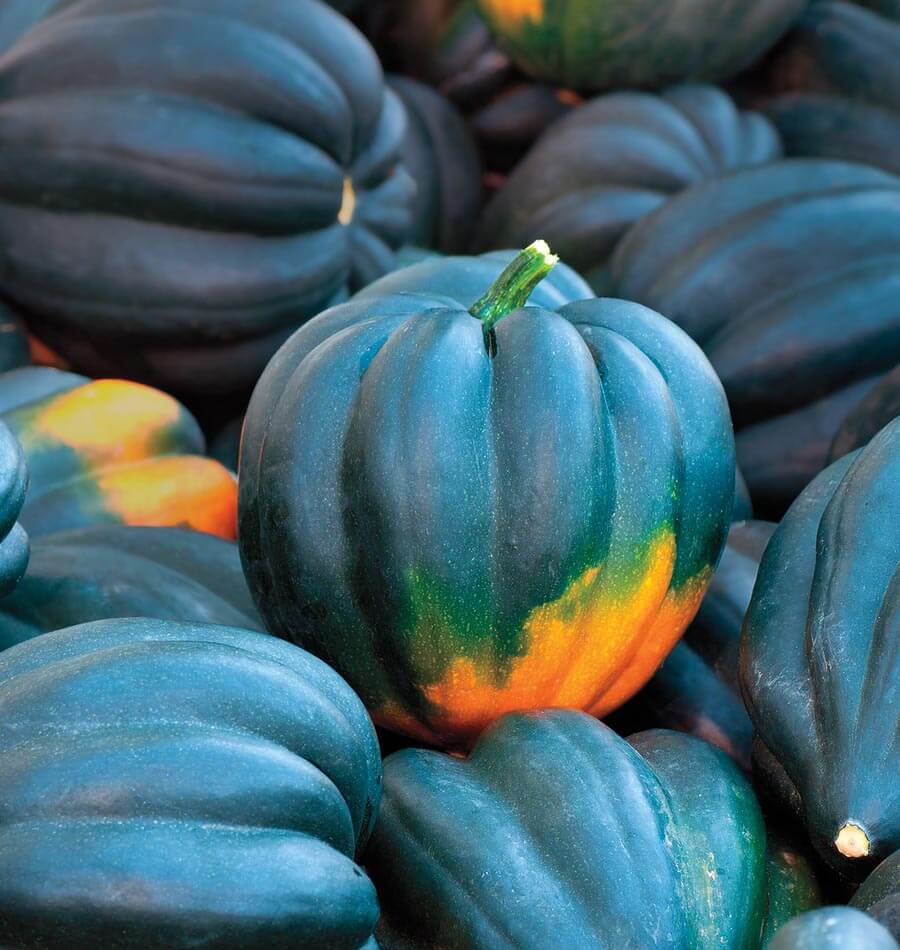
Turbinata variety. Also called Pepper Squash.
Varieties:
Table Queen acorn squash are a reliable old heirloom. This very old variety was introduced commercially by the Iowa Seed Company in Des Moines in 1913. This variety is believed to be derived from the nearly similar strain traditionally cultivated by the Arikara Indians.
Dark green skins and a pronounced acorn shape on fruits that average 15cm (6″) in diameter. Table Queen has excellent storage ability. The long vines are prolific and exceptionally early. The sweet interior flesh is bright yellow, but turns to a golden orange colour in storage. For best storage, allow the fruits to ripen fully on the vine, and harvest just before frost. Wipe the fruits down with a weak bleach solution, and store in a cool, dry place. Choose one with a dull green rind; an acorn squash that's turned orange will have tough and fibrous flesh.
Matures in 85 days.
Royal Acorn
A variety that is a third larger than a regular acorn. Has very productive and vigorous vines. 90 days. Green in color with lighter spots and orange pulp, dry and with the smell of walnut. The taste improves with preservation,
which can last up to 8 months.
King Bush Table Acorn
Non-running acorn squash of the group "Acorn". Very hard epidermis of dark green color. Stringy orange flesh but very fragrant. Sweet almond flavor. 4 to 8 fruits of 0.5 to 1.5 kg per plant. Preservation: 3 to 6 months. Growth: 80 to 110 days.
This variety was selected by the University of Connecticut in 1974.
Tuffy
Very sweet.
A unique, delicious acorn squash for baking, with thicker, sweeter, drier yellow flesh than others.
Black-green skin, distinctive heavy ribbing. Avg. 2 lb. Vining plant habit. NOTES: (1) Rind is tough. Use care when cutting in half for baking. (2) For best sweetness wait two weeks or more after harvest. This variety was created by seed Johnny's in Maine, USA
Sweet Reba
One of the best of the bush acorns. High yielding green-skinned (4-5 fruits/plant) with a good sweet flavor. Bred by Cornell University. Resistant Early Bush Acorn (REBA) lives up to its name as it yields well even in wet climates where disease challenges abound for the pepo types of squash. Does great in semi-arid climate too.
Table Star
Reno
If you don't have enough room to plant a winter squash, think again. Reno offers all the goodness of a traditional acorn squash on a single-stemmed, bushy plant that's respectful of your garden space. These dark green fruit reach 5 inches across and 1 1/2 pounds apiece with very refined, golden flesh that's flavorful and sweet. 75 days.
|
|
Also called Hopi Groie. Ancient Southwestern squash variety believed to have been grown in Anasazi times. Original seed was reputedly discovered in a cave in the Four Corners region, just inside the Utah border. The seeds were found sealed in pottery jars by industrialist George Hoddy in the 1960s. Planting the seeds in his Michigan garden, Hoddy was amazed that they grew. This land-race squash variety is orange-fleshed. The fruits run a wide range of shapes from large banana fruits through slightly flattened spheres, and occasional squat tear-drops. Colors include sea-foam green and salmon. Flesh is somewhat fibrous but is of excellent flavor. Our grower says to use it as you would a hubbard squash. A positively stunning piece of American prehistory.
|
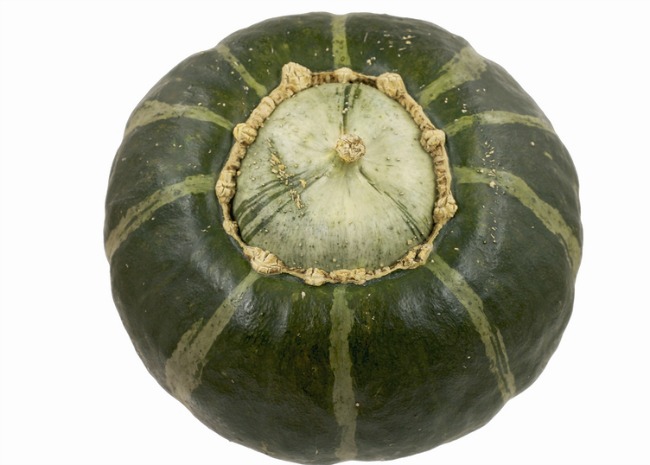
Very suitable for cooking, sometimes has a turban shape. Slightly less flavor than kabocha.
Buttercup squash meat is smooth, with a deep orange color. It can lean towards being a bit dry, so try steaming, simmering, stewing, and baking to bring out its natural sweetness while adding moisture. Its mild flavor makes it pair exceptionally well with hard cheeses, nuts, beef, lentils, and pumpkin pie spice. A close relative of Hubbard and banana squash.
Excellent food qualities and is one of the more highly regarded winter squashes for culinary purposes. Good Keeper. Sweetness will increase with proper storage. This squash is an excellent climber and is recommend for growing on a lattice or fence.
The turban shaped Buttercups were bred in 1927, being more desirable than Hubbards for the small size and thicker flesh. See Page 4 of the Oregon PDF
This squash began as a cross between the “Quality” and “Essex” squashes.
BUTTERCUP TYPES
Burgess Buttercup
This plant produces 3-4 lb. blocky, dark green fruits. Harvest when the spot touching the ground changes to orange. Large vine.
Delica F1: the interior color was dark orange, a little yellower near the skin. The exterior was very dark green, the darkest of any we have trialed. The flesh looked a little dry and crumbly, but the texture was smooth and very creamy. The overall flavor was good. It was mild and sweet, though not quite as sweet as Sweet Mama F1. The group was divided over which one was better.
Has become popular in Italy.
Sweet Mama F1
The interior was a bright burnt orange color, it had less of a color gradient than Delica. The exterior was almost as dark green. The flesh had a smoother, moister appearance than Delica. Generally, the Sweet Mama was quite a bit larger than Delica, we have seen this to be true over the years. The texture was not quite as smooth as Delica, but it was much moister. Many thought that Sweet Mama was tastier and sweeter than Delica, with a less concentrated flavor. We liked them both.
This Japanese kabocha squash has a distinct growing habit and produces a vine with almost no side branches. The 3-4 lb fruits have dark green skin and are borne close to the root end making it possible to interplant these vines quite closely.
Culinary tips: Use in tempura, stir-fry, curries or baked. The Japanese prepare it by simmering peeled chunks in chicken broth or dashi and flavoring with soy sauce and mirin.
Baby Delica F1
In 2011 we decided we liked the texture of the full size Delica over the Baby Delica, however they were a nice size.
Orange Cutie F1: an orange mini kabocha, we trialed this in 2011, and loved the tight bush habit and high yield. We liked the flavor better than Orange Summer F1, the texture was dry.
vegtrials
adaptiveseeds Discus variety
seedsofchange Discus Variety
Uncle David's Dakota Dessert
Exceptional variety of Buttercup, resembling a Turkish Green Turban. Fruits from 2 to 3 kg. Orange flesh very sweet. Good productivity. Very rustic variety, tolerant to cold summers.
Bush Buttercup
Old variety introduced in 1952 in the USA.
Bon Bon F1
|
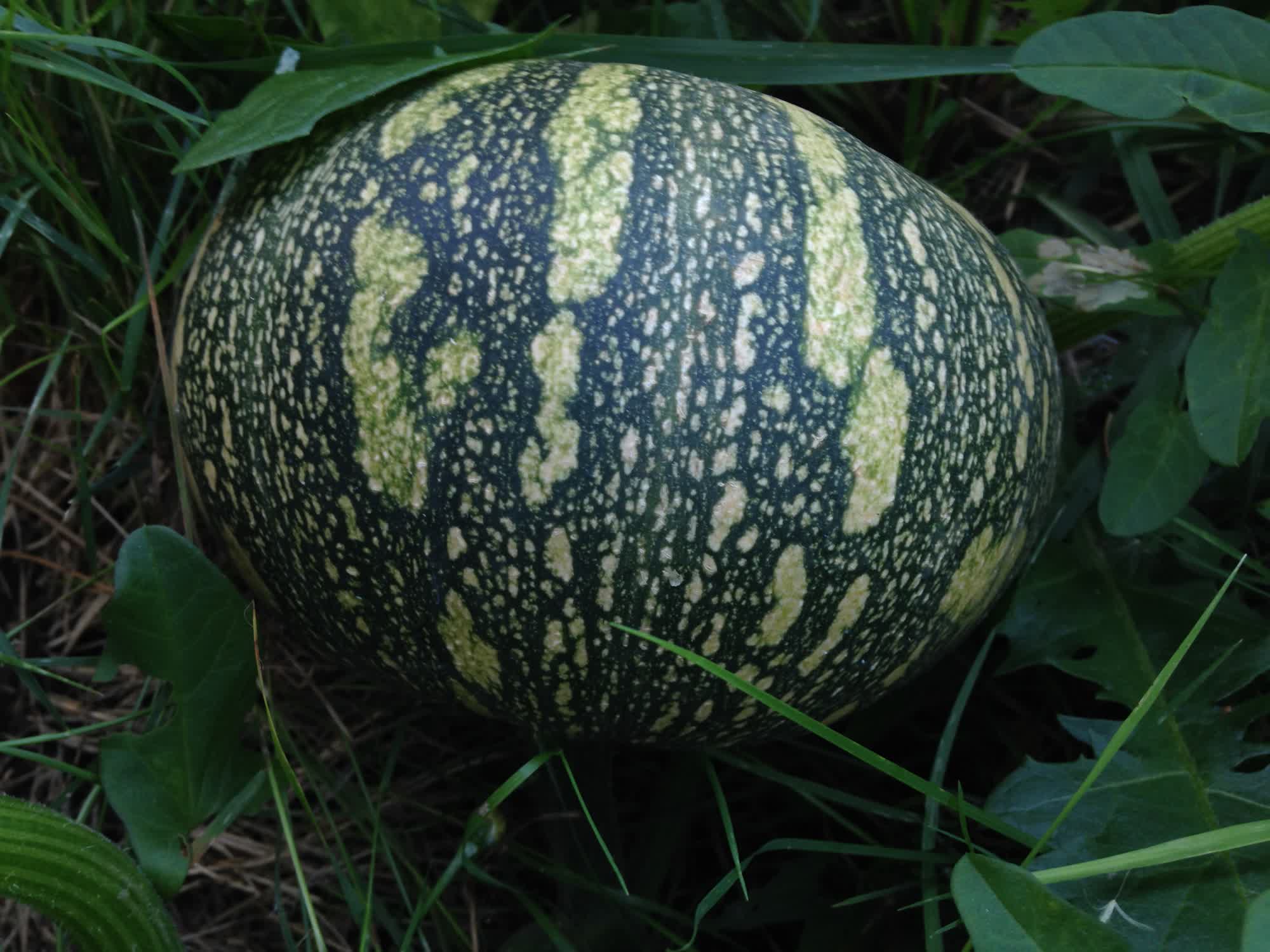
Known as Jamaican Calabash, Jamaican pumpkin, Calabaza, Caribbean Pumpkin, or Cuban Squash.
Calabaza is a squash variety, grown Widely in Jamaica throughout Caribbean as well in the Central - and South America . It is a creeping, annual tropical vine with large lobed leaves and branching tendrils; the flesh of the fruit is bright orange. The flowers are yellow and pollination is done by bees.
The leaves are mottled and grayish green in color. It can be as large as a watermelon or as small as a cantaloupe. The color of calabaza can also vary and may include greens, tans, reds and oranges. Some squash are all one color while other calabaza are multi-colored and may include all of colors listed above.
The fruits vary in size, shape, and color owing to outcrossing and strain selection.
Fruit weighs about 5-12 pounds, and is round and flattened a bit on the top and bottom. Its colors are mottled green or yellow and buff-cream. The taste is sweet and Calabaza is used in many west Indianian Latin and Chinese dishes.
Its firm yellowish-orange flesh is mild and sweet. Heisler likes to saute it with scallops in a white wine sauce and serve over buttered noodles.
Varieties:
La Estrella F1
Green, Tan, and Red-Orange skin. Excellent color. Nearly rib-less. Flavorful and stores well. A Rupp exclusive from the University of Florida. Bred by Dr. Don Maynard for uniform fruit size and superior flesh color. A preferred fruit of the World Championship Punkin Chunkin Association. Weight: 3.0 kg - 4.0 kg Maturity: 110 days
Veruga Bolla
Patrick Simcox, while on an expedition to Panama, discovered this distinct landrace of moschata squash. The fruits are small, round and flattened, and covered with large bumps. Undoubtedly, this landrace is resilient to pests and should thrive in hot humid areas with at least 4-5 months of growing season. Because this is a landrace, we expect there to be variability with the fruits, but in all cases save the seeds as this is rare material.
|
|
Dostal Cucumber. Donated to SSE by Arthur Dostal. A variety grown by his parents, Lewis and Mary Dostal of Tama Co., Iowa, who reportedly received it from family friends. Sweet flavor with buttery smooth texture when grown as a winter squash, but also delicious as a summer squash. 90 days.
Traditionally grown as a winter squash, but tastes good as a summer squash too. Vines produce cream white green fruit maturing to dark green that are similar in size and shape to a cucumber.
Seed Reviews:
Minnesota: The fruits look like green Delicatas and are turning orange in storage. Their flavor is good, a bit like a Delicata, but not spectacular. The main drawback to this variety is that it is quite late compared to the other varieties that we grow.
|
|
Courge du Perou, or squash of Peru is a South American variety. Plant: vine; Fruits: egg-like, dark green, smooth skin; cream; Size (DxH): 30-40 x 40-50 cm; Flesh: yellow to light orange; very thick, dry, finely grained, good quality; Usage-Recommendation: Soup, Puree, Oven, Steam, Deep-Fry. Storage time: +++ Weight: 10.0 kg - 15.0 kg Maturity: 110 days
|
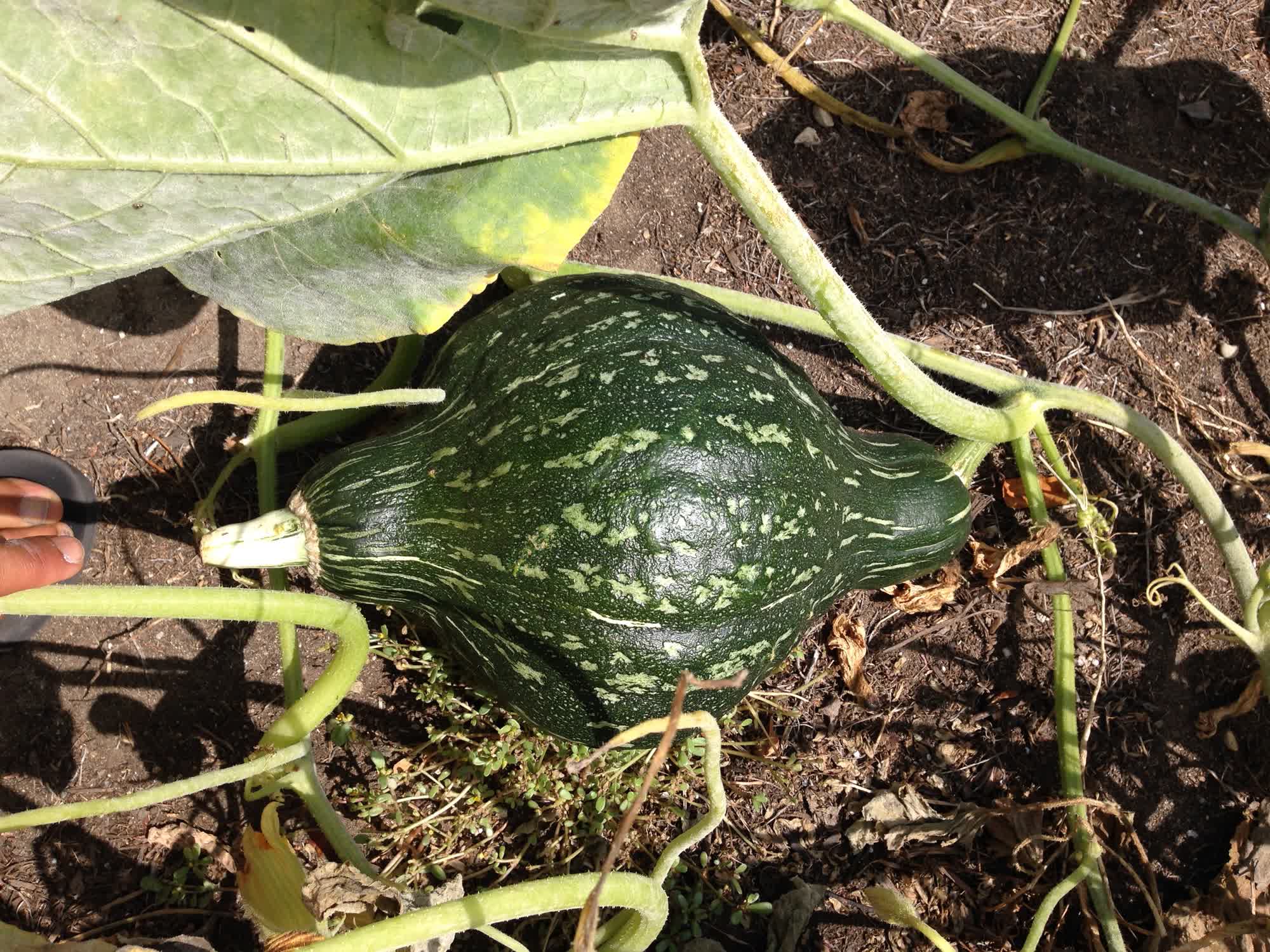
The squash gained its name and popularity by James J. H. Gregory in 1845. Gregory was a New England gardener, innovative seedsman, and philanthropist in Marblehead, Massachusetts. It was a neighbor who prepared a hubbard true green from Gregory’s first harvest and discovered its rich orange flesh and excellent sweet flavor.
It was named in honor of Miss Elizabeth Hubbard, their washerwoman, who made her known. Elizabeth Hubbard had obtained her seeds from Captain Knott Martin. According to the Gregory family, this variety was introduced from Boston to Marblehead around 1798. It would come from the Caribbean or South America. There is a depiction of a green warty hubbard stained yellow in a still life painting from 1820 in Philadelphia. The "Green Hubbard" is also called, today, "True Hubbard".
The superb quality and hardiness of the hubbard green squash lives true to this day. Our hubbards have been extremely successful in the two consecutive years we’ve grown them and have averaged between 15 to 30 pounds each! The flesh is plentiful, highly nutritious, and versatile in its cooking uses, ex. sweeter and more flavorful than pumpkins in pie as well as meaty in vegetarian curry dishes.
Hubbards are all full-flavoured, sweet, usually moist and ‘buttery’ in texture. Some varieties are a bit drier (e.g. blue/grey hubbard) and some are moister (e.g. green hubbard, and all the orange ones). The original variety of Hubbard squash is native to South America. The Hubbard squash is thought to have been grown in New England since the 1830's and sold commercially since 1909.
Varieties:
Hubbard Green Verrucous
The plants extend considerably (up to 4-5 meters) before producing many spindle-shaped fruits. They are up to 7 kg. The epidermis is totally warty and bronze green in color. Thick, dry, yellow-orange flesh, with fine texture and excellent flavor. Very good preservation capacity. Growth: 105-115 days.
This traditional variety from the USA is also called "Chicago Warted Hubbard". It was developed in 1894 from the "Green Hubbard".
Olive Green Pumpkin
Origin: South America. Cultivated in France since 1880.
It is a runner plant that extends about 3 meters. (Growth: 110 to 130 days)
There are 3 to 4 fruits per foot, from 3 to 5 kg. The fruits look like a big olive, 20 to 25 cm in diameter.
The epidermis is olive green. It is smooth, with some small asperities when it is ripe, and therefore thin easy to peel.
The flesh, yellow in color, is thick, stringy and floury. Excellent taste quality especially after a storage time. (In January, the flesh becomes melting and sweet).
It is used in many preparations: gratin, puree, soufflé, donuts, jam.
The fruits are harvested at maturity, that is to say around mid-October. They are kept from 3 to 7 months.
Anna Swartz Hubbard Squash
Known for its hard shell and for being excellent keeper, this squash has thick flesh said to taste somewhat like sweet potatoes. It usually grows from 5-8 pounds. The Anna Swartz Hubbard was a family heirloom of Anna Swartz, and introduced by the Seed Savers Exchange in 1999. Known to produce a variety of shapes mixed between hubbard and turban.
|
|
Also called Calabaza Buen Gusto (Spanish), or Dulce de Horno.
The name, translated from Spanish, means “good-taste-of-the-oven.”
Dulce de Horno Squash is flattened, with dark green, rough, thin rind ripening to pale orange, with heavy ribbing. The squash will weigh up to 10 pounds (4 1/2 kg.)
Inside, it has sweet, dense orangey-yellow flesh with good flavour. The plant grows as a rambling vine.
|
|
In Haiti, this butternut squash relative is called Joumou, named for Soup Joumou, a dish of great national and cultural importance. It is the plant and the dish that commemorates the Haitian Revolution of 1804, and marks the independence of the Haitian people from slavery. It is a reminder of the struggle for freedom that must be renewed year after year.
|
|
|
|
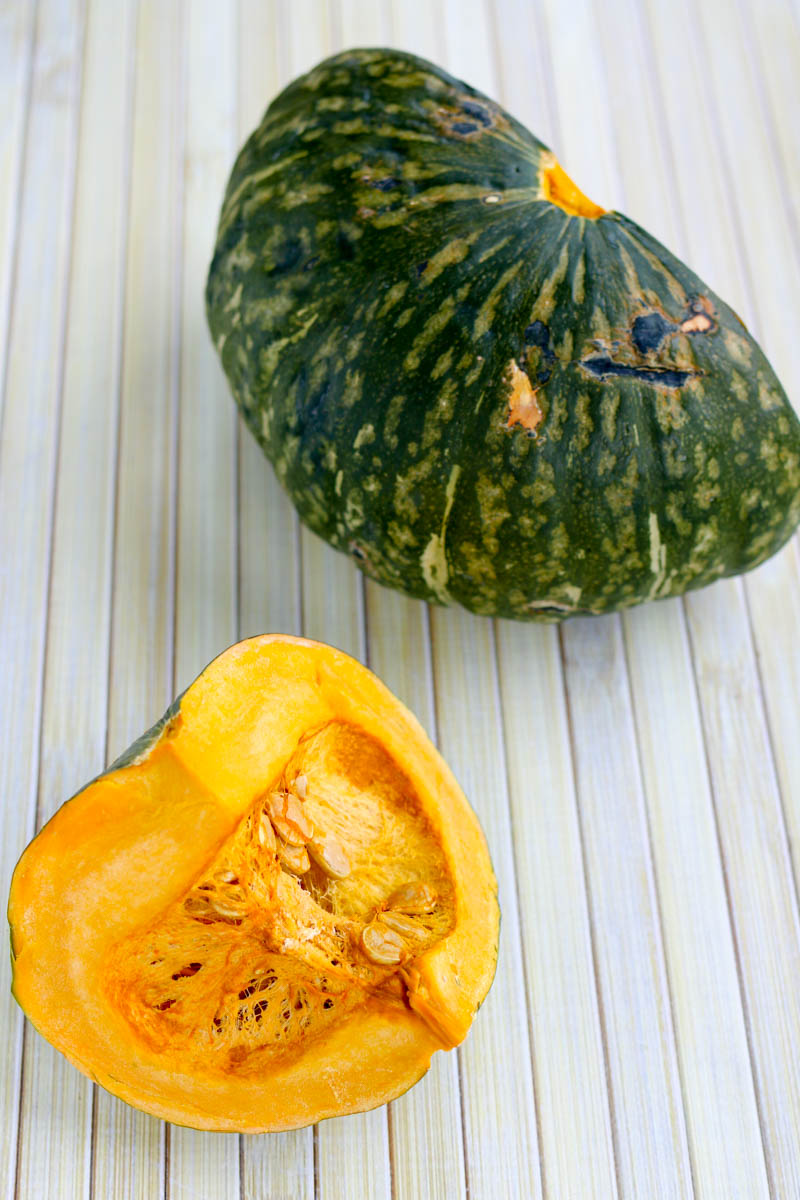
It's sweeter than butternut, with beautiful orange flesh that's reminiscent of a sweet potato in color. Although the buttercup is very close in appearance to the kabocha, the texture of this compact squash is much drier and the flavor much more mild than its nutty and sweet look-alike.
Varieties:
Green Hokkaido
Variety runner. Epidermis of green-gray color. Round fruits 10 to 15 cm in diameter with slightly marked ribs. Yellow flesh very soft, not very fibrous and dry. Each plant can carry 1 to 3 fruits from 1 to 2.5 kg. Preservation: almost 1 year. Growth: 100 days.
From Japan.
Potiron Doux
Pumpkin of small dimensions, in France where it is favored, it is called "potiron doux" and it is mainly used for risotto. Also known as Sweet Pumpkin or French Cake, or "dolce francese" in Italian.
A runner variety producing 2 to 4 fruits per foot, 12 to 15 cm in diameter and 9 to 12 cm in height, from 1 to 4 kg on average. The flesh of Hokkaido Sweet Green Pumpkin is dark orange, thick, sweet, sweet, of good quality for soup, puree, gratin, flan.
Meruhen
This variety was introduced in Japan in 1995. In Japan Meruhen is occasionally sold under its German name 'Märchen' which means fairytale.
Plant: vine;Fruits: rounded, considerably flattened on top and at the bottom; Size (DxH): 15 - 19 cm x 8 - 12 cm; Flesh: dark yellow; dry, firm; sweet, excellent chestnut flavour; Usage-Recommendation: Soup, Puree, Oven, Steam, Deep-Fry Storage time: +++ Weight: 1.2 kg - 1.8 kg. Maturity: 130 days
Shokichi Green (F1)
Attractive, mini kabocha.
Small green fruit with lighter stripes makes a perfect single serving at ½ - 1¼ lb. Very good flavor and texture. Its diminutive size allows it to double as a table-top ornamental. Avg. yield: 5-7 fruit/plant. Avg. 2,600 seeds/lb. 100 Days
|
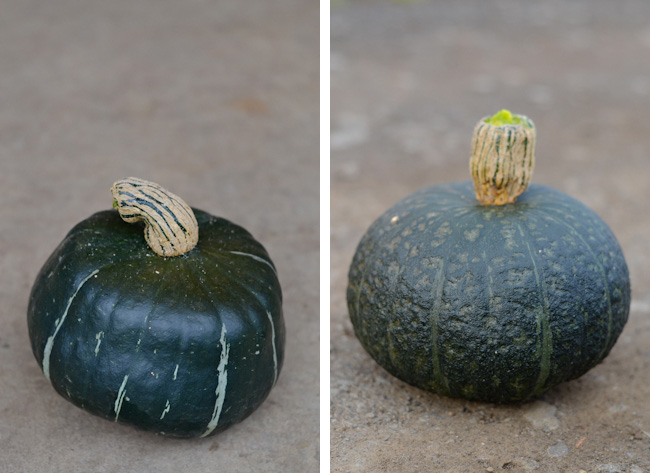
Buttercup squash is a lot like kabocha with a belly button — but generally a little larger, a little moister, and not as nuanced in terms of flavor.
Kabocha is round with no imperfections on button, the area where the turban grows on a Buttercup.
Buttercup shape is different more square.
The kabocha stem shape is different as well, not squishy. It’s more like a tree trunk.
However, the single most important characteristic is that tiny button bottom.. no variation in it.. smooth, non issue.. If it’s bumpy or raised, or two levels, even if it is not a traditional buttercup cap, it still ain’t a kabocha butt.
Taste: The buttercup is wet and kinda goes to goo no matter what you do to it…and didn’t make a good fry. Kabocha tastes more substantial. The texture of kabocha is denser to me and there is just a taste to it that is different. It stays in chunks easier.
It seems that a kabocha/buttercup hybrid is often sold in stores, as the buttercup turban rarely shows and the shape is rounded yet flat.
Johnny seeds kabocha/buttercup hybrids.
kabocha-vs-buttercup Thread
Sweet Mama Hybrid Kabocha (maxima; maturity 75 days)
Black Forest (Buttercup)
Black Forest is a Kabocha type button-less Buttercup. It has a deep orange fiber-less flesh. It is medium-dry with a rich sweet flavor. Buttercups become sweeter after a few weeks, so don't be afraid to store this one. This variety is native to the United States. It is also called "Buttonless Buttercup".
|
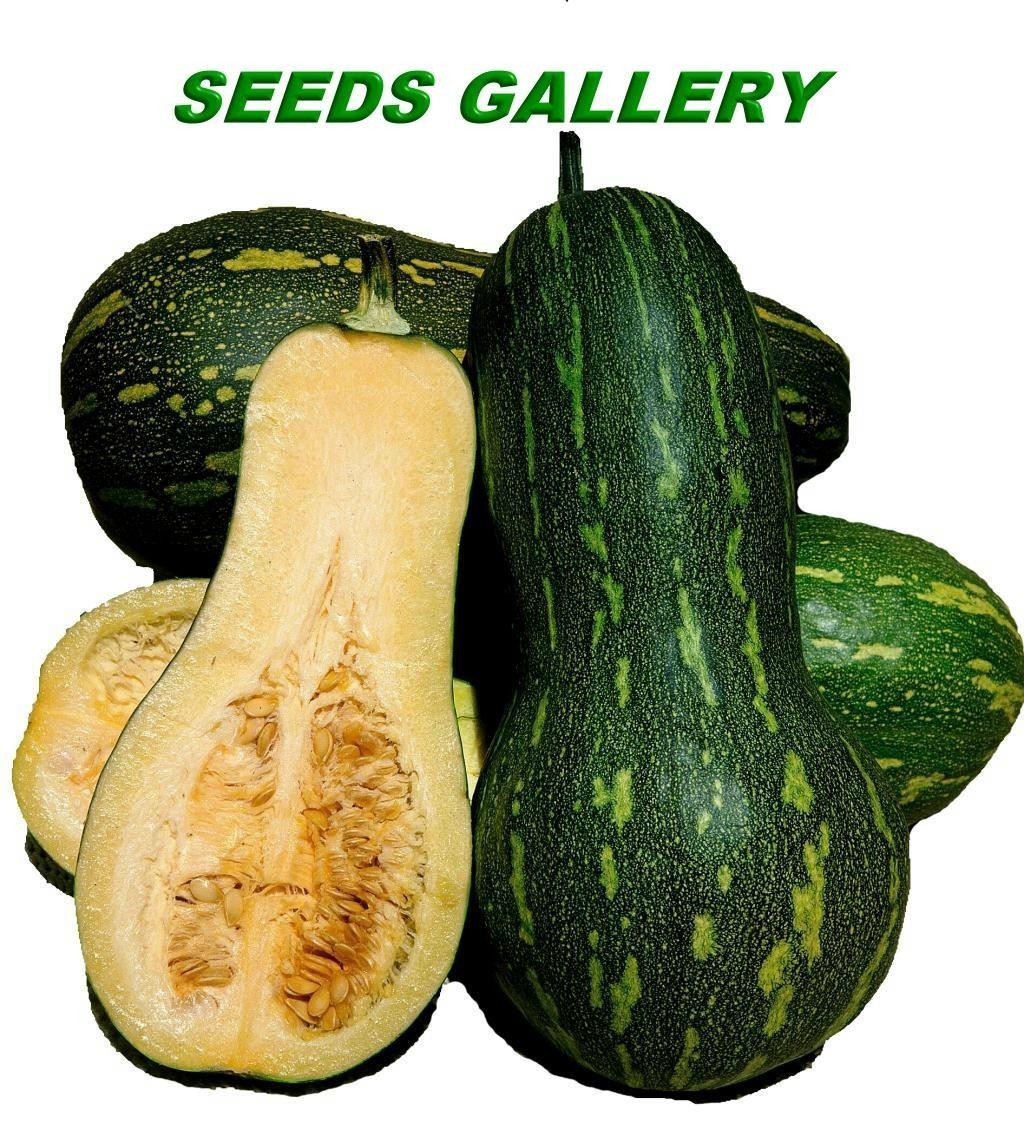
Very suitable for cooking. This squash is an old Italian heirloom. It looks like a cross between a butternut and a La Estrella, only much larger. It has a rich sweet flesh and is good for all baking purposes.
Large, oblong-butternut shaped fruit can weigh 25 kg. The flesh is bright orange, flavor is superbly rich and very sweet. The skin is deep green, turning tan in storage. These are attractive squash and great for areas with warm, long seasons. A good heirloom for home or market. A beautiful very old Italian heirloom that was listed in America by Fearing Burr in 1863; very rare in the USA. It is mentioned in the work of Vilmorin-Andrieux "The Vegetable Plants" in 1856.
Also known as Pleine de Naples, Violin, Bedouin, Coat Rack or Carpet Bag.
Varieties:
Nice long
Very long fruits with a very fine flavor are often curved up to 1 m long. They can be eaten young or at full maturity. Their weight varies from 3 to 10 kg and their diameter from 10 to 18 cm. The epidermis is first light green then ocher at maturity. The orange flesh is firm, musky and slightly sweet.
This ancient variety is native to the south of France.
Taiwan Honey
Taiwan Honey is a new hybrid variety developed from the well-known high quality squash in Taiwan. The plant is very vigorous and strong branching for setting lots of fruits in warm climates.
Muscatnaya
A variety from Russia. Weight: 5.0 kg - 7.0 kg. Maturity: 100 days
Calabaza Pequena Asar
Means small roast squash in Portuguese. Very sugary sweet flesh.
Zapallo de Tula
In the province of Herrera in Panama this variety of squash is commonly grown around the town of Tula. A farmer on the side of the road was selling these attractive beauties and he told Patrick, Joe's brother that the flesh was "Muy Rico" -"very good!" This squash is grown in the hot dry areas but does well in hot humid areas as well according to our Panamanian Farmer Informant. The necks of this squash are long and meaty and the flesh is of good baking or cooking quality. A favorite in Panama. This Moschata variety probably needs a long growing season to be sure, but we would tell anyone with Moschata Squash growing experience to try it as it is well worth the effort to see if it will produce for you.
San Jose Mountain
San Jose Mountain is a an heirloom pumpkin variety from Costa Rica where it is still widely grown today. The fruit is shaped like a club or an oversize butternut with smooth rind that starts out a dark green colour and turns a burnt umber tan colour as it matures. The huge vines will produce fruit ranging from 4kg to 9kg in around 110 days. Flesh is a rich deep orange colour, firm, dryish and lovely sweet. Seeds are all in the bulb end, so the rest is all flesh. This variety was previously unheard of in Australia and is understandably rare.
Chinese Pumpkin
Some understand it to be a home garden/ market garden variety and has a more exact variety name, but translation is difficult. The fruit is only small, usually paw paw shaped, although some fruit are more squat. The rind is mainly green with lots of yellow flecks, but this does turn more yellow in storage. The flesh is a bright yellow/orange colour, firm and moist with a tasty sweetness. This variety is delicious when roasted. Most of the seeds are in the bulb end. Apparently, the seeds are great when roasted. The vines are quite productive and picked fruit ranged from 1kg to 1.9kg, in 95 days over summer.
|
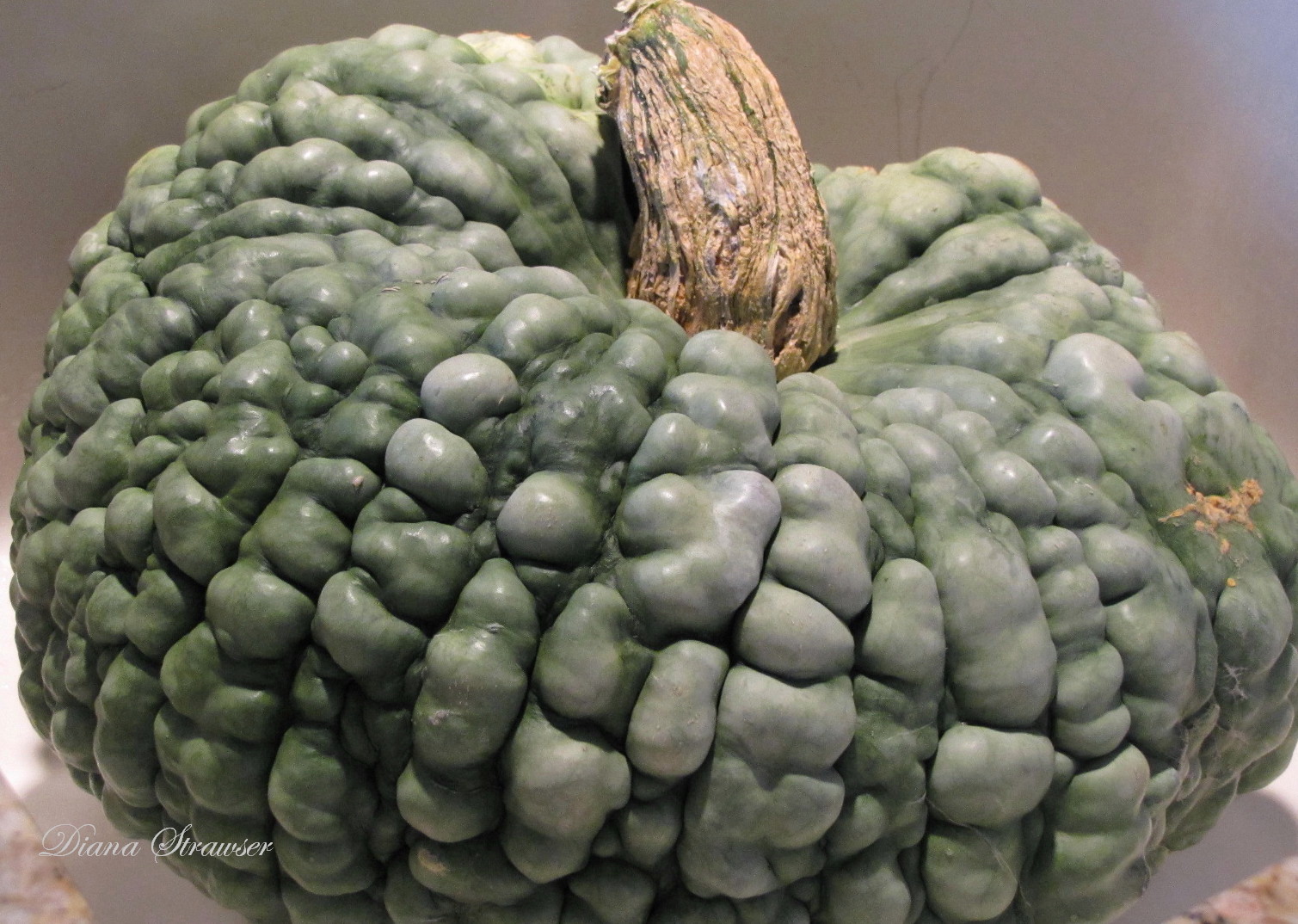
Very suitable for cooking
The heirloom winter squash comes from the small Italian seaside village of Chioggia. The dry, sweet flesh is ideal for Italian recipes that call for squash. The fruit weigh about 10 lbs. each and are produced on vigorous vines.
A magnificent traditional Italian variety of excellent gastronomic quality: ideal for pumpkin tortelli and gnocchi. Present in Italy for several centuries, it has, like all C. maxima, its point of origin in South America. Also known as Zucca Santa or Zucca Barucca; this term derives from the union of wart and the Jewish word baruch (holy, blessed).
Varieties:
Berrettina Piacentina from Piacenza region of northern Italy.
Cappello Del Prete (Priest's Hat)
The name derives from the form that sometimes acquires, which is reminiscent of a turban hat. Traditionally widespread in the lowlands of Reggio and Mantua. Remember the " Marina di Chioggia ", but with less rusticated epidermis. The gastronomic quality is excellent: firm, sweet and fiber-free: ideal for preparing traditional pumpkin tortelli.
|
|
A cherished family heirloom from the great state of Nebraska, this beautiful variety is named for it’s unique skin color, which resembles the plumage of the Nebraska state bird, the Meadowlark. Seeds of this delectable winter squash originated in the garden of Nettie Myers in Fullerton, Nebraska in 1940 and have been passed down over three generations. In 1995 seeds were entrusted to Andrew Koziol who has maintained the purity of the seeds and has brought this incredible variety to our attention. The long slender fruits of this winter squash are perfectly suited to cutting lengthwise and stuffing. Folks can’t get enough of the exquisite flavor and convenient form after all, meadowlark was selected by and for the home cook.
|
|
Redondo di Tronco is a variety native to South America, but also reported of Italian origin. Winter Marrow type.
Bushy and non-running plant that needs two square meters.
Fruit rounded, flattened, slightly ribbed, 11 to 14 cm in diameter, 7 to 9 cm thick, 400 to 600 g. Dark green epidermis when the fruits are young becoming coppery as they age.
Orange flesh with fine grain.
Maturity: 95 days.
Conservation: 2 to 5 months.
They can be stuffed and baked.
Can be harvested immature for consumption, the plant is very rich. In South America, it is used as summer squash, like young patissons and others.
|

Also known as Shark’s Fin Melon, Siam pumpkin, Fig leaf gourd, Chilacayote and Pie Melon (in Australia and New Zealand).
Squash has a distinct smell of melon, creamy white flesh and large pale seeds. The flesh is fibrous when it’s raw, and breaks down into strands (a bit like thick fish bones) when it’s cooked.
Its name has a curious origin: it was introduced in France from that region when Yaks were imported for the Natural History Museum in Paris and these pumpkins were used for feeding animals during the trip. The seeds of some residual fruit were sown at the "Jardin des Plantes" of the French capital, and from there it spread to Europe. The pumpkin is actually native to Mexico, where it was already present in pre-Columbian times: the Aztecs called it "Tzilicayotli", in Spanish "Chilacayote".
The plant is extremely productive and an author of the end of '800 reported that from 4 plants he managed to get 70 fruits, with a total weight of 370 kg.
The appearance more than that of a pumpkin is similar to a watermelon jam. The pulp is white, filamentous and sweet, the black seeds. It is used for jams. It is kept for more than two years.
Fig Leaf Gourd, or Feigenblattkürbis in German, is a strong vigorous plant. In Central Europe it is mainly used as an underlay for cucumbers, because the roots are resistant to soil fungi of the fusarium group. Plant: very large vine; vines up to 30 meter long;
Fruit: green, white marmorated, highround; Size: (DxH): 17 - 23 cm x 20 - 25 cm; Flesh: white, very fibrous, astringent, and very sweet; Usage Recommendation: Oven, Steam, Sweet Dishes, Decoration. Storage time: +++++ Weight: 2.0 kg - 5.0 kg Maturity: 130 days
Another edible New World species is the Malabar or fig-leaf gourd (C. ficifolia). Unlike the squashes and pumpkins, it is a perennial vine that thrives at higher elevations (above 3,000 feet or 1000 m). It is common around Quito, Ecuador, where a single plant may cover an entire vacant lot.
|
|
Triamble Squash is also called Triangle, Tristar or Shamrock. Triamble Squash made its first "known" appearance in an 1918 Australian Seed Catalog where it is said to have come from; and imported from Australia in 1932, from seed secured from Arthur Yates and Co., of Sydney. This squash is lobed like a three-leaf clover, making this light sea-green squash unusual looking.
Skin is hard perfect for shipping and storage. Triamble has a dark orange, dense sweet flesh that is delicious. Average in size from 8-12 lbs Traimble has a very small seed cavity leaving lots of room for sweet flesh. Some even eat it raw. storage squash root sellerTriamble is an excellent storage squash. It holds its flavor and texture for many months.
Seed reviews:
Grown successfully in USA.
Connecticut:Amazing flavour, keeps 4 months.
New Hampshire: Not as prolific.
|
|
Vert d'Espagne or Green of Spain. The flattest winter squash. Green, fine bumpy skin that turns grayish, orange-yellow flesh, quite thick. It weighs 3 to 5 kg.
|
|
|
 MBZ
MBZ
